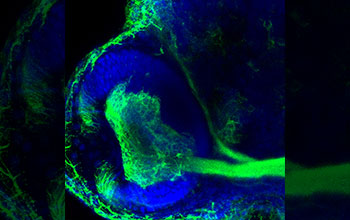Multimedia Gallery
Eye of a zebrafish embryo
The eye of a zebrafish embryo deficient in the enzyme NADPH oxidase 2 has an enlarged ganglion cell layer (green) and altered innervation of the brain, which leads to problems with signaling between the eyes and the brain.
More about this image
Some level of molecules linked to oxidative stress may be essential to health and development, according to new animal studies.
Reactive molecules derived from molecular oxygen, known as reactive oxygen species (ROS), increase dramatically in the body during times of environmental stress or disease. This stress can result in significant damage to cells and is associated with negative health consequences such as aging, male infertility, degenerative diseases and cancer.
"We think there’s an ideal intermediate concentration, but neither extreme is good," said Daniel Suter, a professor of biological sciences at Purdue University.
Suter and a team of researchers looked at an enzyme that produces ROS in zebrafish embryos to see if it’s essential to the development of their nervous systems. Inhibiting this enzyme, NADPH oxidase (Nox), resulted in complications with signaling between the eyes and the brain.
The research team used a drug called celastrol to inhibit Nox activity, which led to defects in the formation of the ganglion cell layer and optic nerve, both of which send signals from the retina of the eye to the brain.
Then, needing to confirm their result using another approach, they used CRISPR -- a system for modifying genes in living cells and organisms -- to mutate Nox genes in the zebrafish embryo. This method also allowed them to differentiate between different isoforms of Nox. Their findings showed that Nox2 could be functionally important to neuronal development, whereas mutations in Nox5 could lead to more general developmental problems.
This research was supported in part by the Natonal Science Foundation (NSF). Learn more about this research in the NSF News From the Field story Chemicals associated with oxidative stress may be essential to development. (Date image taken: unknown; date originally posted to NSF Multimedia Gallery: Dec. 17, 2018)
Credit: Daniel Suter/Purdue University
Images and other media in the National Science Foundation Multimedia Gallery are available for use in print and electronic material by NSF employees, members of the media, university staff, teachers and the general public. All media in the gallery are intended for personal, educational and nonprofit/non-commercial use only.
Images credited to the National Science Foundation, a federal agency, are in the public domain. The images were created by employees of the United States Government as part of their official duties or prepared by contractors as "works for hire" for NSF. You may freely use NSF-credited images and, at your discretion, credit NSF with a "Courtesy: National Science Foundation" notation.
Additional information about general usage can be found in Conditions.
Also Available:
Download the high-resolution JPG version of the image. (1.0 MB)
Use your mouse to right-click (Mac users may need to Ctrl-click) the link above and choose the option that will save the file or target to your computer.



